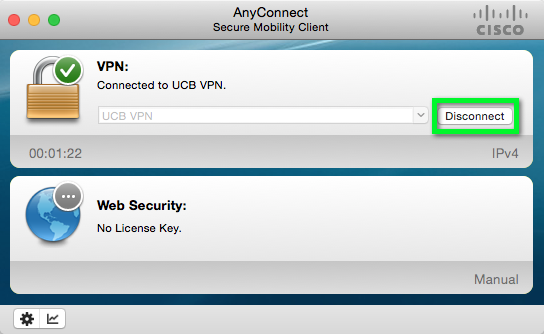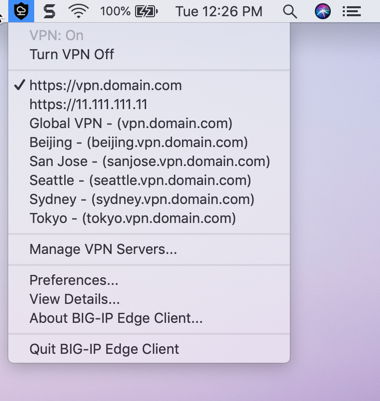

The Super client chooses among all available clients by finding a best match between the domain name given in a query and the names of all known clients. A special meta-client, known as the “Super” DNS client acts as a router for DNS queries. Each client has a symbolic name which is of the same format as a domain name, e.g. Each client can perform DNS queries and searches independent of other clients. Each DNS client has its own set of nameserver addresses and its own set of operational parameters.
F5 vpn client for mac mac os x#
Mac OS X uses a DNS search strategy that supports multiple DNS client configurations. Changes to the DNS configuration should be made by using the Network Preferences panel. Note that the /etc/nf file, which contains configuration for the default (or “primary”) DNS resolver client, is maintained automatically by Mac OS X and should not be edited manually. Mac OS X supports a DNS search strategy that may involve multiple DNS resolver clients.Įach DNS client is configured using the contents of a single configuration file of the format described below, or from a property list supplied from some other system configuration database. I was reading the resolver(5) man page and came across the following: If you want to do the same then netstat -nr is your friend.
F5 vpn client for mac how to#
Sudo killall - HUP mDNSResponder sudo killall mDNSResponderHelper sudo dscacheutil - flushcacheĪlso, not related to all this, but something I had to Google on as I didn’t know how to view the routing table in Mac OS. Reach : 0x00020002 (Reachable,Directly Reachable Address)įlags : Scoped, Request A records, Request AAAA records Here was my output btw so you can see my Azure hosted domain has its own name server, while my home domain rakhesh.local has its own (and don’t ask me where the name server for general Internet queries is picked up from … I have no idea!).įlags : Request A records, Request AAAA records But this wasn’t working in my case (or I had configured something wrong – I dunno. From that post I also got the impression you can scope it per interface … so the idea would be that you can scope the name server for my VPN interface to be one, while the name server for my other interfaces to be another. The idea (I think) is that you can say domain xyz.com should be resolved using a particular name server, domain abc.com should be resolved via another, and so on. If you check out this SuperUser post you can see the output of scutil -dns and come across the concept of scoped queries. Best to just ping and see what IP a name resolves to.Īnyways, I didn’t want to go down a scripting route like in that nice blog post so I tried to find an alternative.

Good to know the kind of things scutil can do.Īnd while on this confusing topic it is worth pointing out that tools like nslookup and dig use the resolver provided in /etc/nf so these are not good tools if you want to test what an average Mac OS program might be resolving a particular name to. I would like to point out this post though that shows how one can use scutil to override the DHCP or VPN assigned DNS servers with another. In my case the output of this command showed that the VPN provided resolver for my custom domain was being seen by scutil and yet it wasn’t being used – no idea why. (I am very very sketchy on the details and to be honest I didn’t make much of an effort to figure out the details either). Even though the Mac OS has a /etc/nf file it does not seem to be used rather, the OS has its own way of DNS resolution and scutil -dns lets you see what is configured. I couldn’t find a solution as such to this but learnt about scutil -dns in the process. So turns out many others have noticed and complained about this. Anyways, once I put these in though I thought it should just work out of the box but it didn’t.
F5 vpn client for mac windows 10#
On Windows 10 I didn’t even have to do this – remote DNS and domains were automatically configured as part of connecting.

Continuing with my previous post … as part of configuring it I went to “Advanced” > “DNS” in the VPN connection and put in my remote end DNS server and domain name to search.


 0 kommentar(er)
0 kommentar(er)
